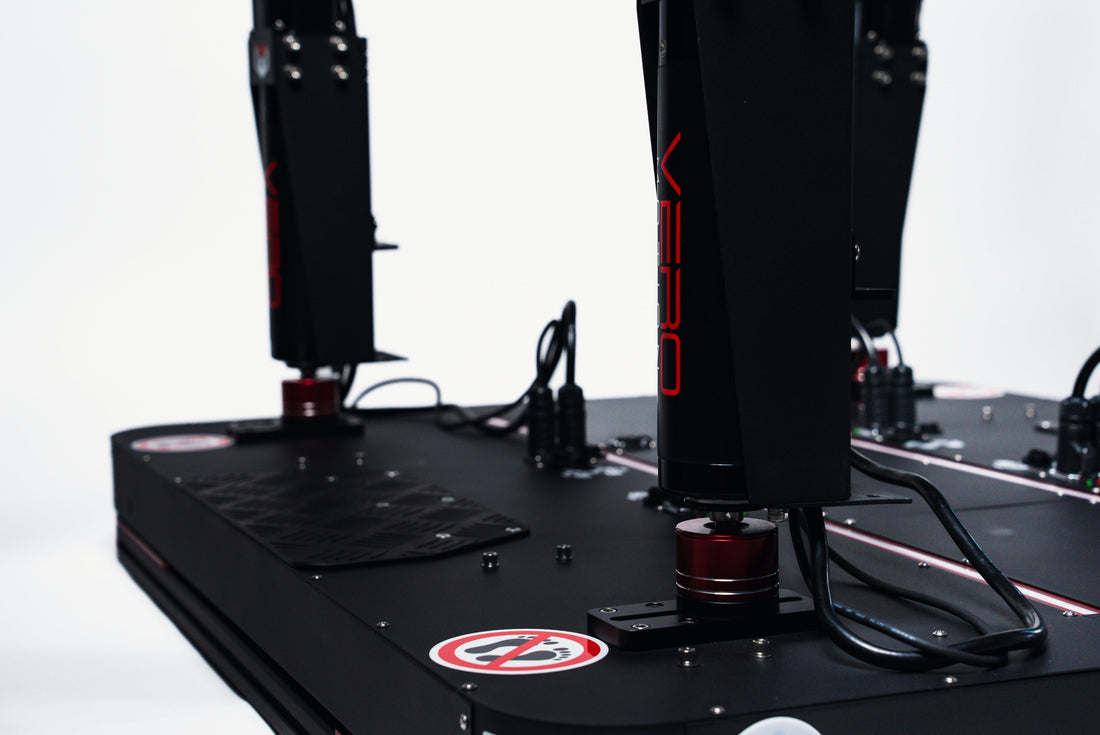
The Best Systems For Motion Sim Racing?
Share
In the realm of sim racing, a multitude of motion systems are available on the market.
With every motion simulator, there are a few benchmarks asked in regards to your simulator.
However... what's involved in a motion simulator?
What's Involved In A Motion Simulator?
A motion simulator replicates the feelings of inertia and movement while in a car or even a plane. And there are two key things that give the simulator the movements.
Actuators
Actuators are the things that will move your sim racing cockpit. Whether it be a motion platform (suspended in the air or similar design) or actuators attached to a cockpit, these are the tools that will move the sim.
Controller
This is the brain of your motion simulator. The control gives the information and "translates" your actuators to your PC. The size of these controllers range from a small pastry to a small server, needing its own shelf and multiple controller units.
What It Does
In sim racing, six degrees of freedom (6DOF) refers to the complete range of motion a simulator can replicate to deliver a realistic driving experience. These include three translational movements along the X, Y, and Z axes—forward/backward movement (surge) along the X-axis, left/right movement (sway) along the Y-axis, and up/down movement (heave) along the Z-axis.
Sorry to get super nerdy about that.
However, three rotational movements bring the car to life: roll (tilting side to side around the longitudinal axis), pitch (tilting forward/backward around the transverse axis), and yaw (rotating left and right around the vertical axis). Together, these six motions allow motion platforms to recreate the forces of acceleration, cornering, braking, and elevation changes, making 6DOF the ultimate standard for immersion in sim racing.
There's a big thing about motion simulators, though.
They're expensive.
Pricing...
I know, money is an awkward conversation no matter the situation.
A quick Google Search shows that some motion systems can go for as low as $3,000 and as high as $150,000 plus.
Some people go for the cheapest thing, but more often than not, those products are "you pay for what you get" type of products.
AKA, the juice ain't worth the squeeze.
How Do You Choose?
So how do you choose your motion system?
With dozens of options it seems impossible.
Thankfully, with testing many products, there are certain benchmarks you can measure in order to determine what system works best for you.
Motion Simulator Benchmarks
Actuator Travel + Travel Speed
- Good Balance
- Not too much of one or the other
- Proper Ratio
Degrees of Freedom
- How many do you want?
- Standard: Roll, Pitch, Heave
- Want Acceleration Feel: Surge
- Want the ability to feel oversteer/understeer: Yaw + Sway
Controller
- Not a lot of room?
- Smaller = better
- Not super complicated
- Not a large and tall control tower
- General consensus = stay away from those unless big money
- Not a large and tall control tower
Mounting Ability
- Mount to flat face + open face?
- Yes = Good
- Even with different brackets
- Yes = Good
- Mount Controller Box to Chassis = BIG PLUS
- For The Wire Management Freaks
- Doesn't Look Out of Place
Price
- How much do you want to spend?
- Anything less than $5,000 might be sketch
- Always do your research
- Don't have to break the bank
- Lots of tested/trusted by other companies/reviewers = what you want.
The Best Systems
In my opinion, there are three main systems for the US market to consider: D-Box, Qubic System, and Vero Motion.
3 DOF Systems

Opinionated Pros & Cons
| System Name | Pros | Cons |
D-Box |
|
|
Qubic System |
|
|
Vero Motion |
|
|
6 DOF Systems

Opinionated Pros & Cons
| System Name | Pros | Cons |
D-Box |
|
|
Qubic System |
|
|
Vero Motion |
|
|
Overall, I feel Qubic System and D-Box hold their own. However, Vero Motion is on the rise.
Their CEO, Marc, continues to improve and innovate on their products, provide phenomenal customer service, and is a true car enthusiast.
With our turnkeys, clients have began to shift their preference to Vero Motion.
Their balance between budget and performance is mind-boggling, which makes Vero Motion our go to for Motion Systems.
Check them out below or send us an email at info@boundlessracing.com for a turnkey racing simulator.


